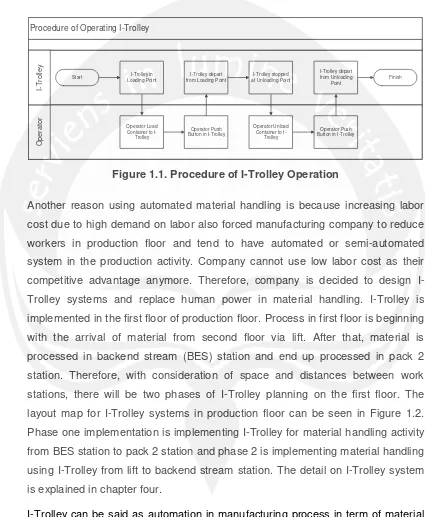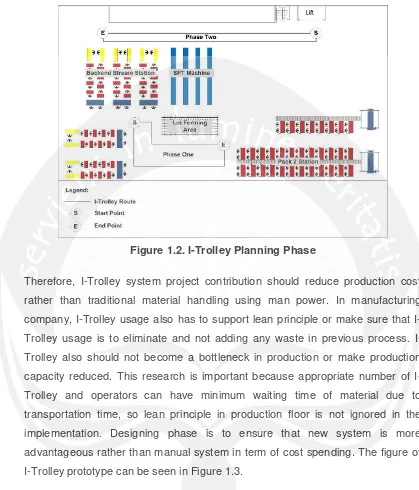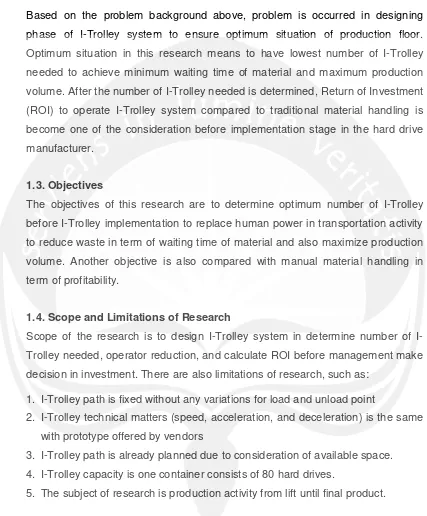1 CHAPTER 1 INTRODUCTION
This chapter is explaining the background of this research, which is determining I-Trolley fleet sizing in a production floor in order to change manual material handling. The problem formulation, objectives, scope, and limitation of this research are also defined as well in this chapter.
1.1. Background
Currently, manufacturing company of this research subject, which is hard drive manufacturer in Thailand, has to face tight competition with many competitors. Company try to have lower price for their products compared to another competitor but still maintain or even higher profit level. The ultimate way to reach the objective is lower the cost to perform an enterprise in form of manufacturing and administration activity.
To respond company objectives, each department responsible to support in their work area. One of department in company, Industrial Engineering Department, is responsible for production activity and make sure that the activity is effective and efficient as possible. In another word, Industrial Engineering Department objectives is to reduce cost in production activity without any reduction on quality, capacity, and reliability. Lean principle becomes one of guideline that can be implemented in the production to achieve the objective. The basic of lean principle is to detect any waste occurred and eliminating waste to have lower manufacturing cost without sacrificing product quality because waste is actually a non-value added activity in production. Waste can be in form of over processing, inventory, transportation, over production, rework, motion, and waiting (Marchwinski & Shook, 2003)
2
AGV is the most popular because one of the reason is AGV can transport almost all type of material to support manufacturing process (Lin et al., 2006). AGV is chose over transportation using man power due to many advantages, such as flexibility, space utilization, productivity, safety, and adaptability with other automated systems (Shneor et al., 2006). Electronic goods manufacturing, in example hard drives manufacturing, also one of well-known example of industry that use AGV in their operations (Gosavi & Grasman, 2009). AGV is known for the best solution of automated material handling in Flexible Manufacturing System (FMS) due to flexibility of AGV route (Leite et al., 2015). The production system in hard drive manufacturer, which is become research subject, can be classified as flow shop. Therefore the concept of AGV is not suitable due to redundancy of the main advantage. Flow shop production system route is fixed from one stations to another stations and all products have same process flow . Instead of using AGV, the manufacturer try to use I-Trolley concept. Currently to support manufacturing activity, company still use manual transportation handling which requires many operators to do the transportation activity. In this project, Industrial Engineering Department is collaborating with Production Engineering Department and Industrial Engineering Department is responsible in calculating the amount of I-Trolley needed to support manufacturing activity and operator reduction to calculate profitability analysis.
I-Trolley principle is actually the same as AGV in term of driverless material handling (Fazlollahtabar & Saidi-Mehrabad, 2015) and consists of many parts, such as: DC Motors, sensors to ensure the safety, wireless communication, and energy sources in form of rechargeable battery (Zajac et al., 2013). The difference between them, I-Trolley is simplification of AGV which are not fully automated and not flexible as AGV system. I-Trolley only has two stop points, one is considered as start point and another is considered as end point. Term usage of start and end point is based on material flow in production. Start point is stop point to load material that ready to be processed to the next station and end point is stop point to unload material in the arrival station.
3
The calculation of transportation times and distances is explained in chapter four. Another consideration of using I-Trolley rather than AGV is because cheaper investment. Cheaper investment is caused by not all features in AGV used in I-Trolley system. The procedure of operator to operate I-I-Trolley can be seen in Figure 1.1.
Procedure of Operating I-Trolley
Operator
I-Trolley
Start Loading PointI-Trolley in
Operator Load Container to
I-Trolley
Operator Push Button in I-Trolley I-Trolley depart from Loading Point
I-Trolley stopped at Unloading Point
Operator Unload Container to
I-Trolley
Operator Push Button in I-Trolley I-Trolley depart from Unloading
Point
[image:3.595.86.511.175.692.2]Finish
Figure 1.1. Procedure of I-Trolley Operation
Another reason using automated material handling is because increasing labor cost due to high demand on labor also forced manufacturing company to reduce workers in production floor and tend to have automated or semi-automated system in the production activity. Company cannot use low labor cost as their competitive advantage anymore. Therefore, company is decided to design I-Trolley systems and replace human power in material handling. I-I-Trolley is implemented in the first floor of production floor. Process in first floor is beginning with the arrival of material from second floor via lift. After that, material is processed in backend stream (BES) station and end up processed in pack 2 station. Therefore, with consideration of space and distances between work stations, there will be two phases of I-Trolley planning on the first floor. The layout map for I-Trolley systems in production floor can be seen in Figure 1.2. Phase one implementation is implementing I-Trolley for material handling activity from BES station to pack 2 station and phase 2 is implementing material handling using I-Trolley from lift to backend stream station. The detail on I-Trolley system is explained in chapter four.
4
Figure 1.2. I-Trolley Planning Phase
5
Figure 1.3. I-Trolley Prototype
1.2. Problem Formulation
Based on the problem background above, problem is occurred in designing phase of I-Trolley system to ensure optimum situation of production floor. Optimum situation in this research means to have lowest number of I-Trolley needed to achieve minimum waiting time of material and maximum production volume. After the number of I-Trolley needed is determined, Return of Investment (ROI) to operate I-Trolley system compared to traditional material handling is become one of the consideration before implementation stage in the hard drive manufacturer.
1.3. Objectives
The objectives of this research are to determine optimum number of I-Trolley before I-Trolley implementation to replace human power in transportation activity to reduce waste in term of waiting time of material and also maximize production volume. Another objective is also compared with manual material handling in term of profitability.
1.4. Scope and Limitations of Research
Scope of the research is to design Trolley system in determine number of I-Trolley needed, operator reduction, and calculate ROI before management make decision in investment. There are also limitations of research, such as:
1. I-Trolley path is fixed without any variations for load and unload point
2. I-Trolley technical matters (speed, acceleration, and deceleration) is the same with prototype offered by vendors
3. I-Trolley path is already planned due to consideration of available space. 4. I-Trolley capacity is one container consists of 80 hard drives.


